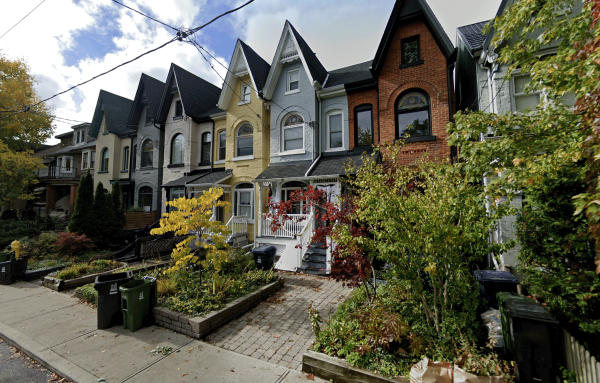At first glance, our house — or I should say, my landlord’s house — is a conventional Harbord Village home. On a quick walk, you’d notice little difference between our three-story semi-detached and the one next door. Yet the same square footage allotted to me and my seven housemates is shared by a retired couple on the opposite side of our adjoining wall. This hidden density is masked by a sea of single-family homes on our safe and quiet one-way street just a breath away from Bloor. We live in a neighbourhood. Better yet, we live in a heritage conservation district.
But this is not a neighbourhood of families. The asymmetry of our street is noticed by the trained eye. This eye counts the City of Toronto Garbage bins on each front lawn. It distinguishes between houses which expose their front rooms, adorned with exotic plants and curated bookshelves, from those with blinds permanently shut. It marvels at the assortment of mismatched, though well-loved, patio furniture on certain porches. For a rooming house in which every square foot has been carved into a single, rentable unit, the porch is an all-season common space made possible by heavy blankets and a commitment to the bit.
Sitting on our porch over the past three and a half years, I have witnessed over 30 tenants cycle through our house. I have lived with family and acquaintances, a handful of folks I hope to be life-long friends, and a few whose names I forget, if I ever knew them. Their presence is made known in the hallway that separates the upstairs unit from the downstairs. You cannot enter our house without tripping over the left-behind shoes of 30 people.
I’d forgive your ignorance if you thought this was student housing — a temporary, “starter” apartment for people in a transitional state of life. Look at the Varsity Blues logo spray painted on the back yard fence! Consider the proximity to U of T campus — only a ten-minute walk! And yet, my housemates range in age from 17 to 40. Only three of us are students. The rest of our lot are cannabis retailers, servers, NGO staffers, university administrators, clown performers, dance instructors, dishwashers, web developers, and film industry workers. Pay attention — most of us have more than one job.
For myself, what began as a university apartment evolved into my permanent residence post-graduation. I relish telling my friends that I pay less than a grand in rent each month. $920, to be exact. Asking my housemates if they plan to re-sign their lease in April — an unnecessary formality that my landlord continues to enforce — all but one said yes. For one of my housemates — a 25-year-old Varsity football player committed to “the hustle” — paying $650 to live in what is ostensibly an attic will enable him to service gargantuan student debt payments after graduation. The house, shoes and all, is a long-term, high-commitment, and expensive adult space.
When I moved in the summer of 2020, I moved into a house of students. A stable collection of folks from U of T maintained by my friend Naomi, who would recruit tenants out of her pool of acquaintances. Landlords offloading their labour — getting tenants to manage, show, and even clean rooming houses — is common practice. Best case scenario, your rent is lowered if you commit to salting the pavement and taking out the bins every week. Worst case scenario, you find yourself in a house like my friend Donny did in Kensington, subletting a room from a woman who leased the entire house only to act as a proxy-landlord. This woman eventually evicted Donny, bringing him to us.
The symbiosis shared between my landlord and the student population was severely disrupted by the pandemic. Throughout the winter of 2020, the upstairs unit sat empty as our laundry room filled with the left-behind belongings of people who thought they’d come back but never did. Although each person continued to pay rent while sitting at home in Yukon, North York, and Türkiye, when their leases expired un-renewed, my landlord opted to market the space on Facebook Marketplace and Kijiji. What ensued was a revolving door of summer sublets, Ukrainian refugees, and folks fleeing from renovictions. Every cancelled lease, a new price tag. In 2022, my landlord evicted a tenant with a month’s notice under the guise of housing his daughter only to rent the room out to the next highest bidder. What was $950 when I first moved in thus became $1125.
The assumption that rooming houses are temporary spaces for a younger, mobile cohort, implies a linear journey through the rental market. Move away from home, into student residence, then a crammed but cute apartment with friends, next a loveable studio, eventually in with a partner, and finally buy property. It is a script for adulthood punctuated by signifiers of upward class mobility that culminates in homeownership. My mum moved from start to finish by the time she was 25. That was in the 90s.
It is commonly accepted by everyone from opinion columnists to the Prime Minister that Millennials are struggling to meet this social script. What the endless discourse over generational home ownership rates misses is the aspiring class of renters that exists within and beyond my own generation, Gen Z. To rent at any age in Toronto is to participate in a market that makes living alone in an apartment with a bathtub and a cat an almost unachievable class signifier. Of my friends who live in this type of “proper” space, each share the financial burden with either a partner or a parent — or better yet, both!
With so many failing to rise to the occasion of the conventional housing script, it is worth questioning some of its constitutive elements. Assuming that everyone wants to live alone at best lacks imagination and at worst actively degrades the city’s affordable rental stock. Yet, this assumption has guided Toronto’s construction boom. Sitting on my porch, I have a clear view over rows of protected heritage houses towards the construction on Spadina. Currently going up includes a rental building with over 70% of its units one-bedroom and an elite student residence with luxury town houses at its base. Neither of these buildings will be able to accommodate my group of housemates in terms of price point nor lifestyle.
Contrary to popular thinking, there are many reasons why communal living is a favourable destination on the housing ladder. Because my lease is independent from my housemates, I reap the many benefits of community — spontaneous social time, shared household labour and costs — while never jeopardizing my housing security when a roommate moves out. The house is also a rare example of a truly diverse rental stock, providing options that range from $450 to $1200. Hear me out, I believe in the value of multi-tenant dwellings. The problem, however, is that our house is neither designed nor licenced to support communal living. Just this morning, I woke up to a message about the dishes. It is always about the dishes.
The city-wide legalization of rooming houses coming into effect at the end of this month is a meaningful step towards regulation. The new framework will not, however, change the fact that I and seven other people live in a house that was built for a single family. Neither will it change the illegal status of my house. My landlord is yet to acquire a license, presumably because our eight units will continue to exceed the zoning permission for low-density residential neighbourhoods. Then again, how exactly can we classify my house, which rents individually to eight tenants but has two separated units, with a bathroom and kitchen in each? At a certain point, the legal-illegal distinction becomes meaningless to everyone save enraged property-owning neighbours.
My property-owning neighbours aren’t enraged. In fact, most of them are quite lovely. I serve many of them brunch at the local restaurant where I work. Rather than inundating the police or local bylaw officers with complaints over our over-flowing garbage or the occasional loud porch hang, they remain silent, saving their voices for where it matters. The Harbord Village Resident’s Association has been petitioning the City since 2013 to extend heritage protection designation to the entire neighbourhood, which is currently threatened by “development and new density.” Though the demand has achieved little movement, its potential speaks to a lack of inclusive planning for the future within downtown residential areas.
Very little innovation exists within the market beyond creatively dividing floor plans to maximize rental income. What Toronto lacks is a robust and diversified rental stock for people at various stages of life attempting to live affordably and communally. The result of this profound lack is that so many of us are living in housing that was not built for us. Consider my cousin, the cannabis retailer, who lives in the basement of our house in a converted storage room with no central heating in the winter. Or look beyond Harbord Village to Yonge and Bloor, where my friend spends $1200 to live in the “den” — a genius though deeply sinister spin on “living room” — of a new-built condo.
The task is not just to build more, but to build purposefully, recognizing the hidden density that already exists within neighbourhoods like my own. For a city that appears permanently under construction, the static of single-family home neighbourhoods is jarring. Yet, I live in one of the most transit accessible areas of Toronto, serviced by a streetcar route to the East and West, Lines 1 and 2 to the North, and a bus route to the South. The neighbourhood is safe, it is walkable, it even has bike lanes! And many people already live here, deceptively hidden behind bay-n-gable façades. To build purposefully is to harmonize what we already have and with what we want. That is, rentals that balance the flexibility, community, and affordability provided by my rooming house, but with a floor plan that rises to the occasion of housing eight adults. A floor plan that, if anything, minimizes your tripping risk when you enter the door.
Zoë (she/her) is a recent U of T graduate who loves Toronto. She is a collection of the people and places that touch her, including all those who have made a home for themselves on the porch.





2 comments
I would hope that even an unlicenced rooming house would have all its wiring to spec for the number of small “households” living there. And fire safety to code, including fire exits for that guy up in the attic. I guess the Rupert Hotel fire happened 35 years ago, before some of the happy residents of today’s overcrowded “shared” spaces were even born.
Sharing kitchens and even bathrooms depends on the tenants and his/her/their tastes and economic states. BUT the city MUST be sure that the wiring is safe and there there are sufficient fire escapes. if these exist (and they cost money) then rents should cover costs and landlords keep the excess.